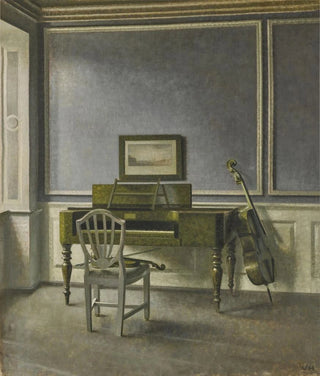Art print | Interior of the music room: Strandgade 30 - Vilhelm Hammershøi


View from behind

Frame (optional)
Interior Art print of the music room: Strandgade 30 - Vilhelm Hammershøi – Captivating introduction
In the world of art, some works manage to transcend time and capture the essence of an era. "Interior of the music room: Strandgade 30" by Vilhelm Hammershøi is one of those creations that invites the viewer to enter a world filled with serenity and mystery. This painting, created in 1901, transports us into the intimacy of a Danish interior, where light plays a leading role. The composition, both simple and refined, evokes an atmosphere of calm conducive to contemplation. Hammershøi, a master of nuances and shadows, succeeds in capturing an ordinary scene while giving it a poetic dimension, making this work a true masterpiece.
Style and uniqueness of the work
Hammershøi's style is distinguished by his unique approach to space and light. In "Interior of the music room," a subtle use of soft tones and pastel colors creates a soothing visual harmony. The walls, delicately illuminated, seem to blend into the interior landscape, while the objects arranged in the room, such as the piano and chairs, come to life under the painter's attentive gaze. The perspective is carefully studied, inviting the viewer to explore the depths of the scene. This work is also characterized by the absence of human figures, leaving room for personal and introspective interpretation. The silence emanating from the canvas is almost palpable, and every detail contributes to the emergence of a contemplative atmosphere.
The artist and his influence
Vilhelm Hammershøi, born in 1864, is often regarded as one of the great masters of Danish realism. His work is marked by a constant search for light and space, influenced by the major artistic currents of his time, such as Impressionism. However, Hammershøi stands out for his introspective approach and his exploration of interiors, places charged with memory and emotion. His ability to transform everyday scenes into works of art of great emotional depth.

Matte finish

View from behind

Frame (optional)
Interior Art print of the music room: Strandgade 30 - Vilhelm Hammershøi – Captivating introduction
In the world of art, some works manage to transcend time and capture the essence of an era. "Interior of the music room: Strandgade 30" by Vilhelm Hammershøi is one of those creations that invites the viewer to enter a world filled with serenity and mystery. This painting, created in 1901, transports us into the intimacy of a Danish interior, where light plays a leading role. The composition, both simple and refined, evokes an atmosphere of calm conducive to contemplation. Hammershøi, a master of nuances and shadows, succeeds in capturing an ordinary scene while giving it a poetic dimension, making this work a true masterpiece.
Style and uniqueness of the work
Hammershøi's style is distinguished by his unique approach to space and light. In "Interior of the music room," a subtle use of soft tones and pastel colors creates a soothing visual harmony. The walls, delicately illuminated, seem to blend into the interior landscape, while the objects arranged in the room, such as the piano and chairs, come to life under the painter's attentive gaze. The perspective is carefully studied, inviting the viewer to explore the depths of the scene. This work is also characterized by the absence of human figures, leaving room for personal and introspective interpretation. The silence emanating from the canvas is almost palpable, and every detail contributes to the emergence of a contemplative atmosphere.
The artist and his influence
Vilhelm Hammershøi, born in 1864, is often regarded as one of the great masters of Danish realism. His work is marked by a constant search for light and space, influenced by the major artistic currents of his time, such as Impressionism. However, Hammershøi stands out for his introspective approach and his exploration of interiors, places charged with memory and emotion. His ability to transform everyday scenes into works of art of great emotional depth.






